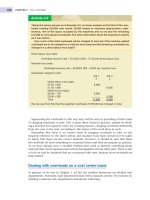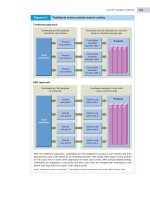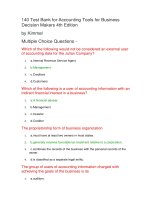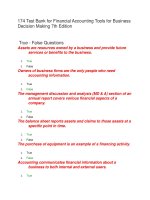Managerial economics economic tools for todays decision makers 7th edtion by keat young and erfle chapter 07
Bạn đang xem bản rút gọn của tài liệu. Xem và tải ngay bản đầy đủ của tài liệu tại đây (285.2 KB, 40 trang )
Chapter 7
The Theory
and Estimation
of Cost
Chapter Outline
•
•
•
•
•
•
•
•
•
Importance of cost in managerial decisions
Definition and use of costs in economic analysis
Relationship between production and cost
Short-run cost function
Long-run cost function
Learning curve
Economies of scope and scale
Supply chain management
Ways companies have cut costs to remain
competitive
Copyright ©2014 Pearson Education, Inc. All rights reserved.
7-2
Learning Objectives
• Define the cost function and the difference between
the short and long run
• Distinguish between economic cost and accounting
cost
• Explain how the concept of relevant cost is used in
economic analysis
• Define total, variable, average and fixed cost
• Explain the linkage between the production and
cost function
• Provide reasons for the existence of economies of
scale and scope
Copyright ©2014 Pearson Education, Inc. All rights reserved.
7-3
Importance of Cost
in Managerial Decisions
• Ways to contain or cut costs popular during the past
decade
–
–
–
–
Most common: reduce number of people on the payroll
Consolidation of shared services
Outsourcing components of the business
Mergers and consolidation (usually with a reduction in employees)
Copyright ©2014 Pearson Education, Inc. All rights reserved.
7-4
Definition and Use of
Cost in Economic Analysis
• Relevant cost: a cost that is affected by a
management decision
• Historical cost: cost incurred at the time of
procurement
• Opportunity cost: amount or subjective value that is
forgone in choosing one activity over the next best
alternative
Copyright ©2014 Pearson Education, Inc. All rights reserved.
7-5
Definition and Use of
Cost in Economic Analysis
• Incremental cost: varies with the range of options
available in the decision
• Sunk cost: does not vary in accordance with
decision alternatives
Copyright ©2014 Pearson Education, Inc. All rights reserved.
7-6
Relationship Between
Production and Cost
• Cost function is simply the production function
expressed in monetary rather than physical units
• We assume the firm is a ‘price taker’ in the input
market
Copyright ©2014 Pearson Education, Inc. All rights reserved.
7-7
Relationship Between
Production and Cost
• Total variable cost (TVC) = the cost associated
with the variable input, found by multiplying the
number of units by the unit price
• Marginal cost (MC) = the rate of change in total
variable cost
–
∆TVC W
MC =
=
∆Q
MP
The law of diminishing returns implies that MC will eventually increase
Copyright ©2014 Pearson Education, Inc. All rights reserved.
7-8
Relationship Between
Production and Cost
Plotting TP and TVC
illustrates that they are
mirror images of each
other
When TP increases at an
increasing rate, TVC
increases at a
decreasing rate
Copyright ©2014 Pearson Education, Inc. All rights reserved.
7-9
Short-run Cost Function
• Short-run cost function assumptions:
–
–
the firm employs two inputs, labor and capital
–
–
the firm produces a single product
the firm operates in a short-run production period where labor is variable, capital is
fixed
the firm employs a fixed level of technology
Copyright ©2014 Pearson Education, Inc. All rights reserved.
7-10
Short-run Cost Function
• More short run cost function assumptions.
–
–
the firm operates at every level of output in the most efficient way
–
the short-run production function is affected by the law of diminishing returns
the firm operates in perfectly competitive input markets and must pay for its inputs
at a given market rate (it is a ‘price taker’)
Copyright ©2014 Pearson Education, Inc. All rights reserved.
7-11
Short-run Cost Function
• Standard variables in the short-run cost function:
–
Quantity (Q) is the amount of output that a firm can produce in the short run
–
Total fixed cost (TFC) is the total cost of using the fixed input, capital (K)
Copyright ©2014 Pearson Education, Inc. All rights reserved.
7-12
Short-run Cost Function
• Standard variables in the short-run cost function:
–
Total variable cost (TVC) is the total cost of using the variable input, labor (L)
–
Total cost (TC) is the total cost of using all the firm’s inputs,
TC = TFC + TVC
Copyright ©2014 Pearson Education, Inc. All rights reserved.
7-13
Short-run Cost Function
• Standard variables in the short-run cost function:
–
Average fixed cost (AFC) is the average per-unit cost of using the fixed input K
–
Average variable cost (AVC) is the average per-unit cost of using the variable input L
AFC = TFC/Q
AVC = TVC/Q
Copyright ©2014 Pearson Education, Inc. All rights reserved.
7-14
Short-run Cost Function
• Standard variables in the short-run cost function:
–
Average total cost (AC) is the average per-unit cost of all the firm’s inputs
–
Marginal cost (MC) is the change in a firm’s total cost (or total variable cost) resulting
AC = AFC + AVC = TC/Q
from a unit change in output
MC = DTC/DQ = DTVC/DQ
Copyright ©2014 Pearson Education, Inc. All rights reserved.
7-15
Short-run Cost Function
• Graphical example of the cost variables
Copyright ©2014 Pearson Education, Inc. All rights reserved.
7-16
Short-run Cost Function
• Important observations
–
–
–
–
AFC declines steadily
when MC = AVC, AVC is at a minimum
when MC < AVC, AVC is falling
when MC > AVC, AVC is rising
The same three rules apply for average cost (AC) as for AVC
Copyright ©2014 Pearson Education, Inc. All rights reserved.
7-17
Short-run Cost Function
Two critical relationships:
• Productivity and cost are inversely related.
• The marginal cost pulls average either up or down
depending on if it is above or below average.
Copyright ©2014 Pearson Education, Inc. All rights reserved.
7-18
Short-run Cost Function
• A reduction in the firm’s fixed cost would cause the
average cost line to shift downward
• A reduction in the firm’s variable cost would cause
all three cost lines (AC, AVC, MC) to shift downward.
Copyright ©2014 Pearson Education, Inc. All rights reserved.
7-19
Short-run Cost Function
Copyright ©2014 Pearson Education, Inc. All rights reserved.
7-20
Short-run Cost Function
• Alternative specifications of the Total Cost function
(relating total cost and output)
–
cubic relationship:
as output increases, total cost first increases at a
decreasing rate, then increases at an increasing rate
Copyright ©2014 Pearson Education, Inc. All rights reserved.
7-21
Short-run Cost Function
• Alternative specifications of the Total Cost function
(relating total cost and output)
–
quadratic relationship: as output increases, total cost increases at an increasing rate
–
linear relationship: as output increases, total cost increases at a constant rate
Copyright ©2014 Pearson Education, Inc. All rights reserved.
7-22
Long-run Cost Function
• In the long run, all inputs to a firm’s production
function may be changed
–
–
–
Because there are no fixed inputs, there are no fixed costs
The firm’s long run marginal cost pertains to returns to scale
In general, at first firms achieve increasing returns to scale, then as they mature
they have constant returns, then they may experience decreasing returns to scale
Copyright ©2014 Pearson Education, Inc. All rights reserved.
7-23
Long-run Cost Function
Copyright ©2014 Pearson Education, Inc. All rights reserved.
7-24
Long-run Cost Function
• When a firm experiences increasing returns to
scale:
–
a proportional increase in all inputs increases output by a greater proportion
–
as output increases by some percentage, total cost of production increases by some
lesser percentage
Copyright ©2014 Pearson Education, Inc. All rights reserved.
7-25









